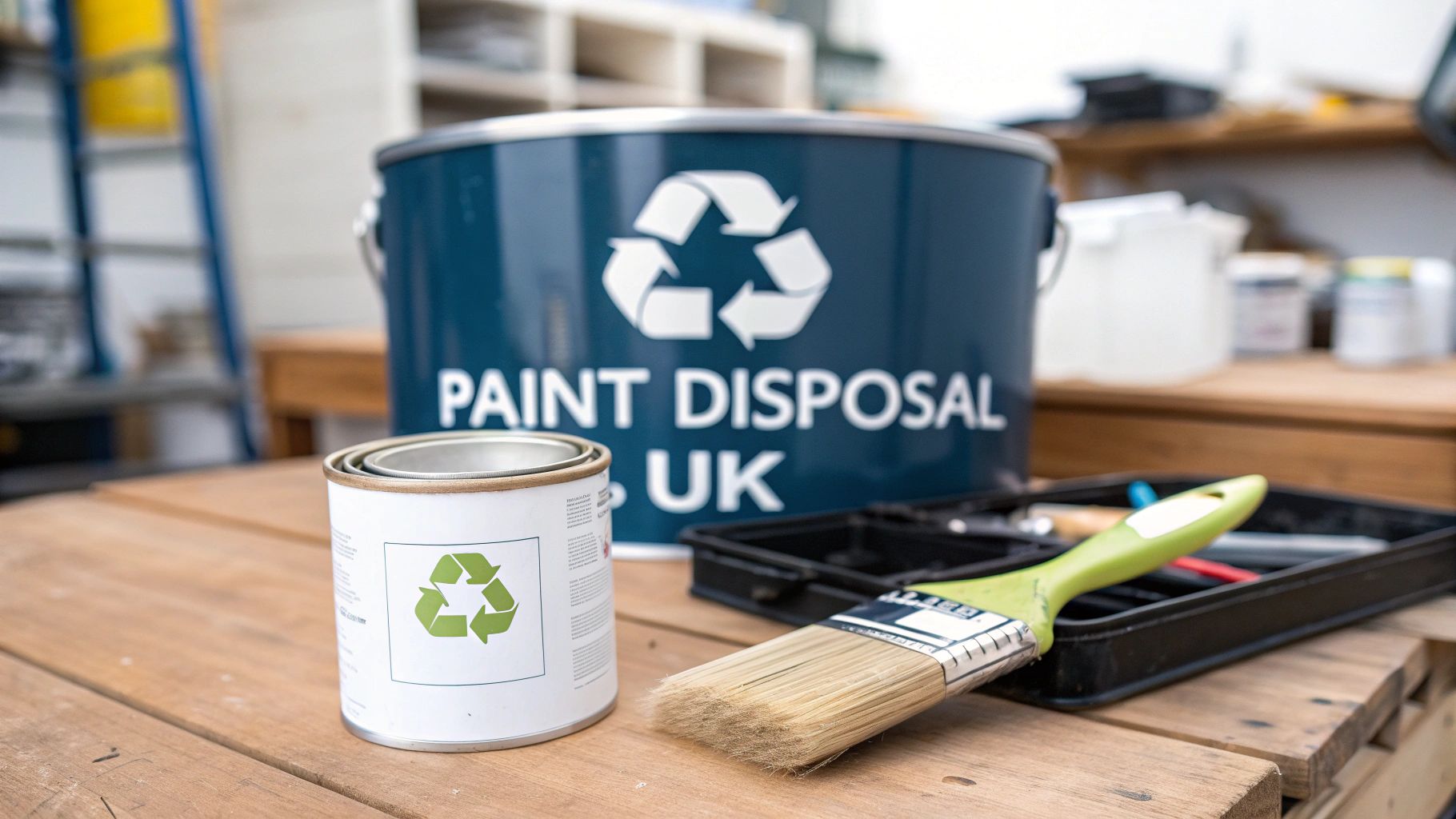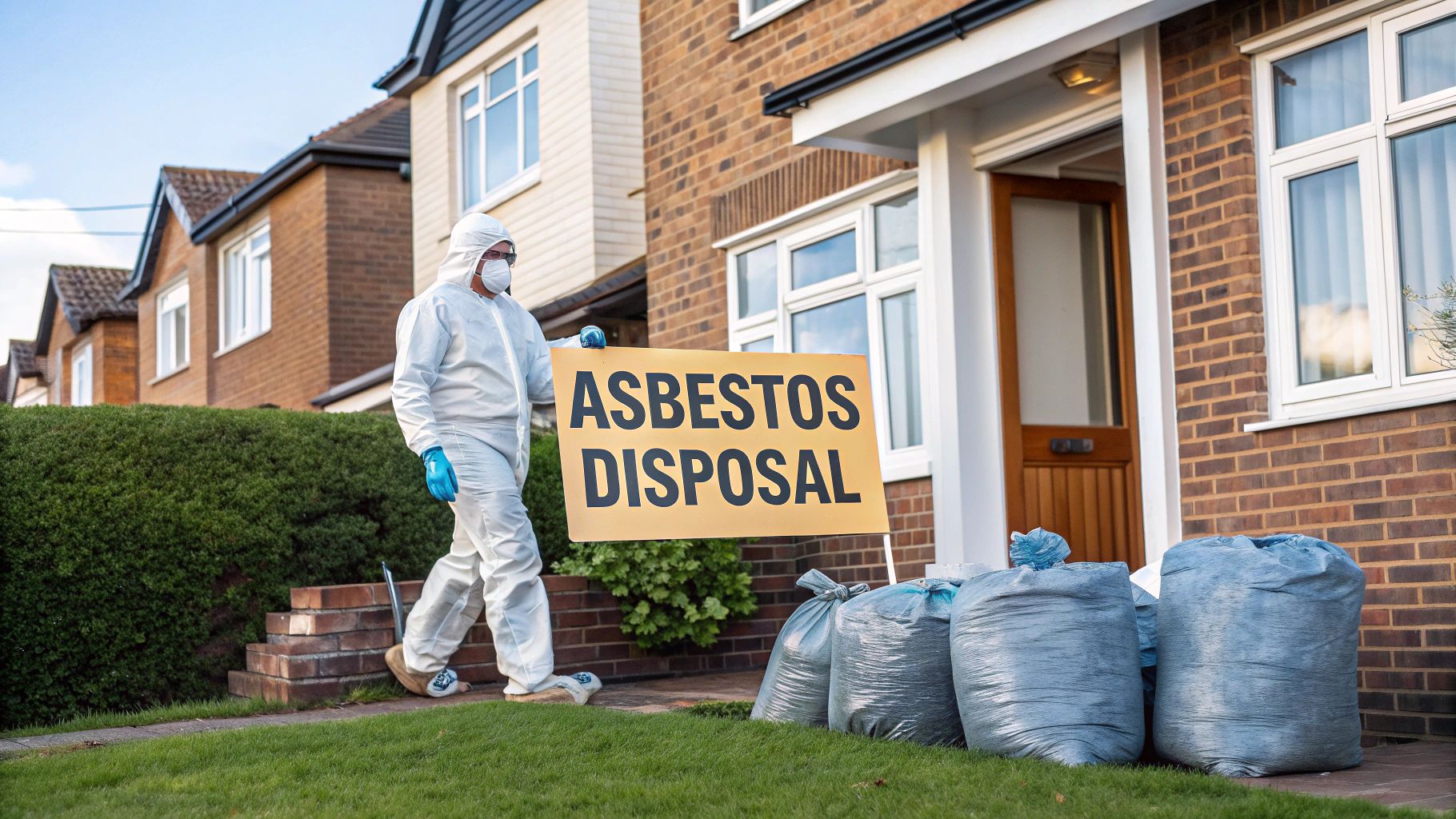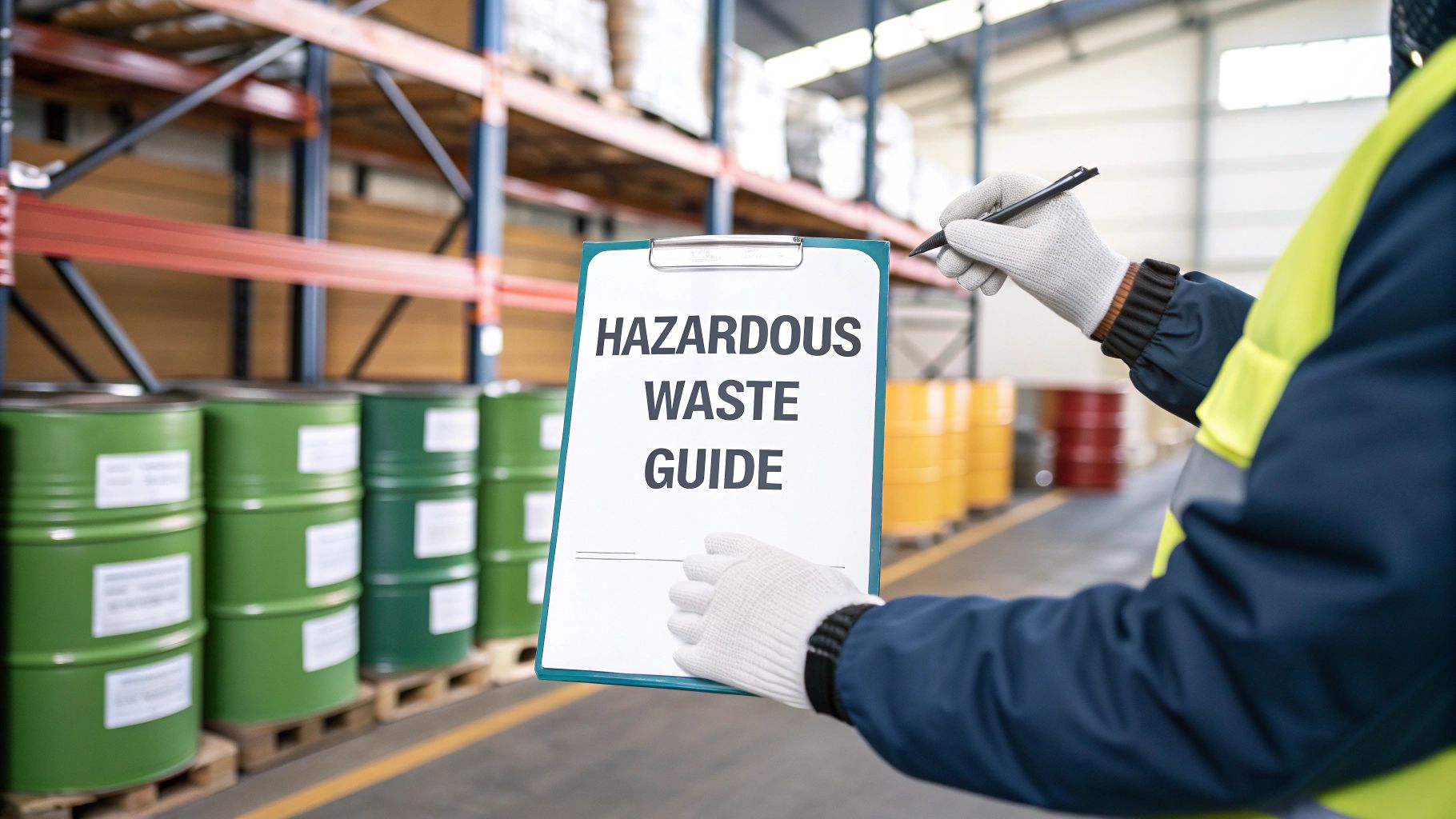Finding Asbestos Removal Near Me A Homeowner’s Guide
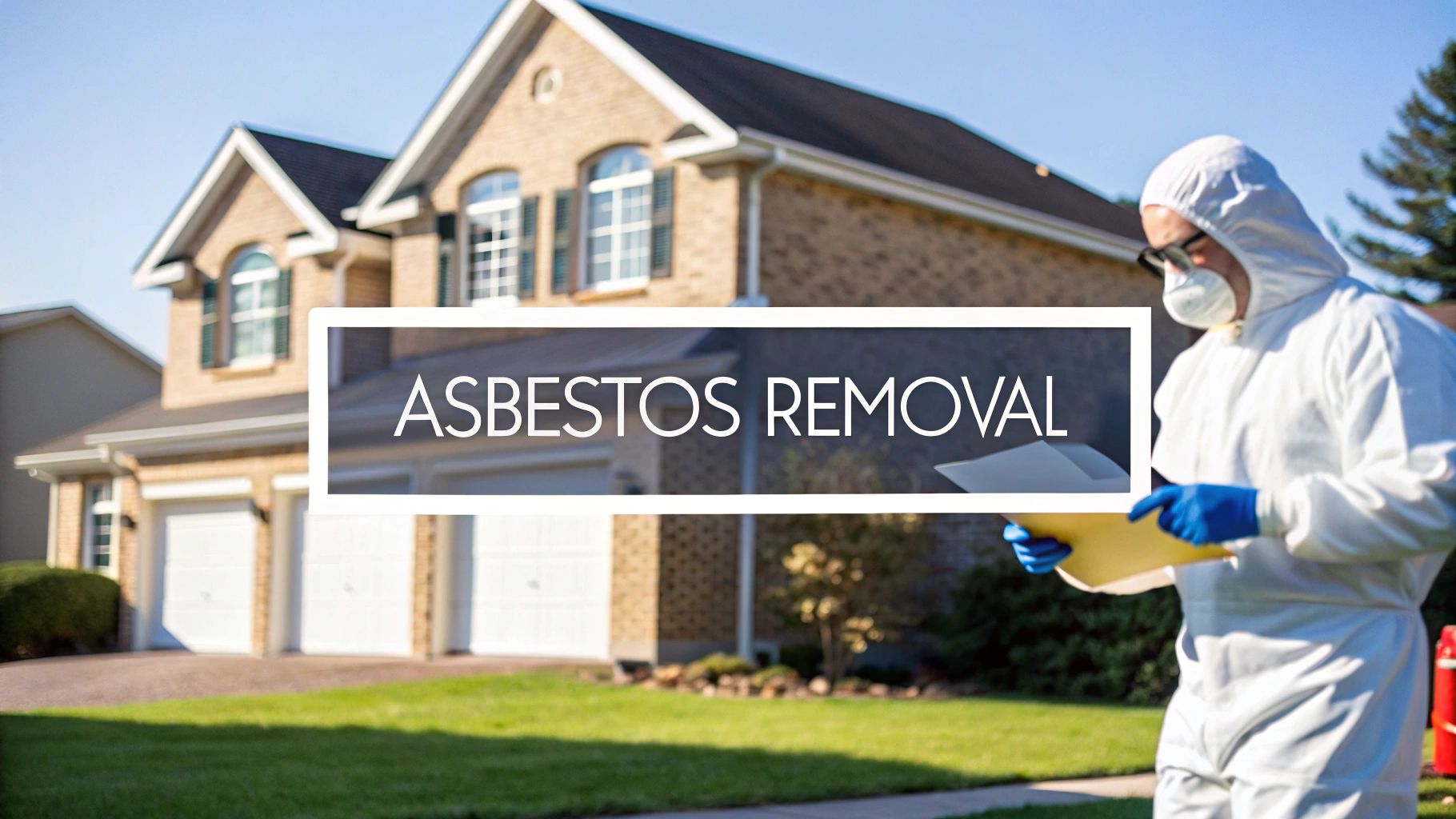
Finding Asbestos Removal Near Me A Homeowner’s Guide
If you’ve found yourself searching for “asbestos removal near me,” you’re probably dealing with a hidden worry in your home. It’s a completely valid concern, especially since millions of UK properties built before the year 2000 still contain it.
Disturbing materials like old ceiling tiles or floor coverings can release dangerous fibres into the air, making professional removal an absolute necessity. This is not a DIY job; you need certified experts who know how to manage the risk properly.
Why Asbestos Is a Lingering UK Problem
Finding asbestos often comes as a shock, turning what seemed like a simple renovation into a major safety headache. For decades, asbestos was hailed as a “miracle mineral” because it was fantastic at resisting fire and providing insulation.
It ended up in countless building materials – everything from cement sheeting and insulation boards to textured coatings like Artex and even old vinyl floor tiles. The problem is, these materials are now ageing, becoming brittle, and far more likely to release those harmful fibres if they get knocked about.
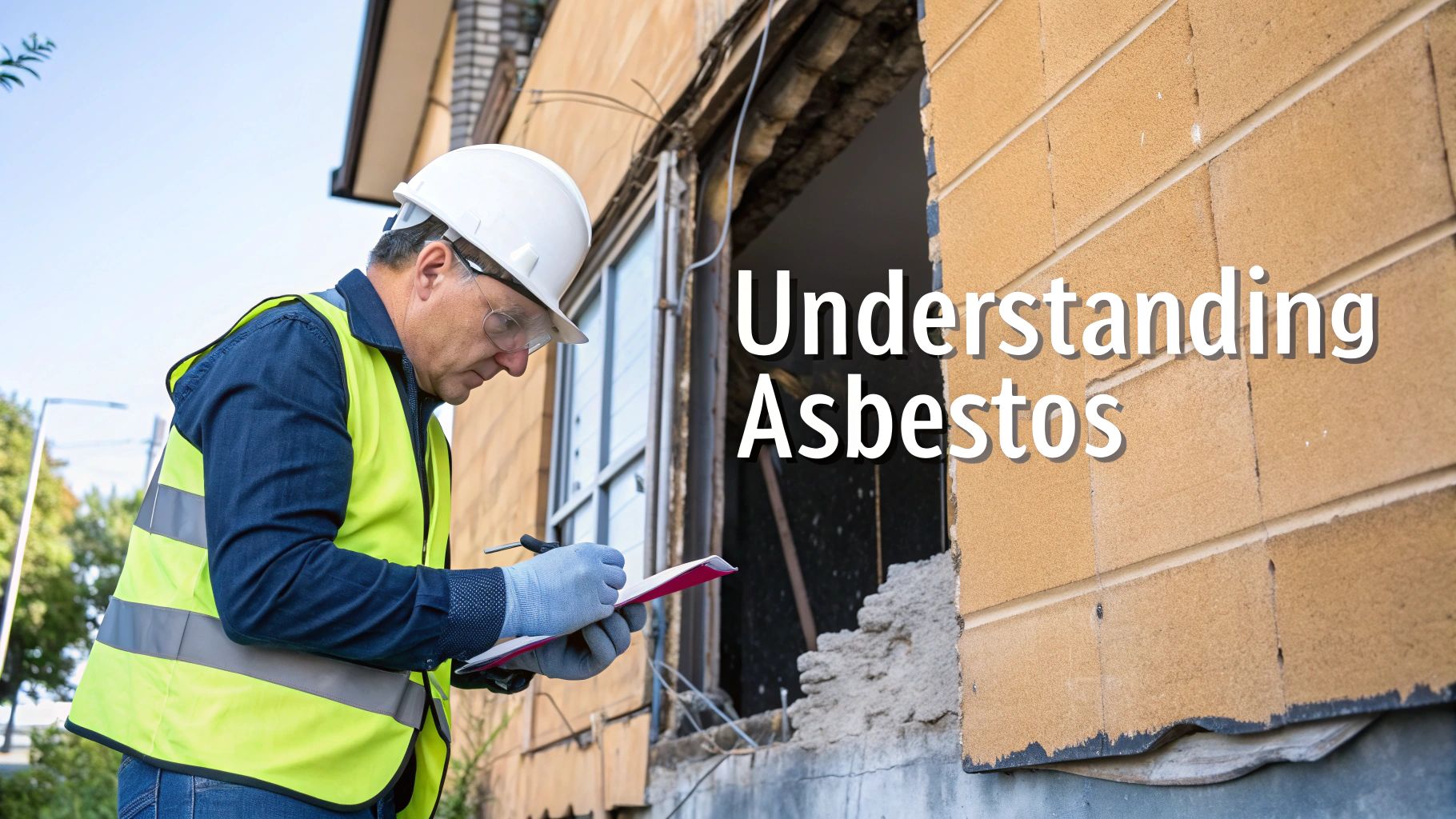
This legacy has created a huge challenge right across the country. The sheer number of older buildings in the UK means the scale of the issue is massive. A staggering 1.5 million buildings are still estimated to contain asbestos.
This isn’t just limited to homes. Around 75% of UK schools are affected, which really highlights just how widespread this hidden hazard is. You can learn more about the impact of asbestos from UK statistics if you want to dig deeper into the numbers.
The Non-Negotiable Need for Professional Help
Trying to remove asbestos yourself is not just incredibly dangerous, it’s also illegal in many situations. Without the proper containment, ventilation, and personal protective equipment (PPE), you risk contaminating your entire home and exposing your family to microscopic fibres that cause severe, long-term health problems.
Professional asbestos removal isn’t just a service; it’s a critical safety procedure. Licensed contractors follow strict Health and Safety Executive (HSE) guidelines to ensure every single fibre is contained, removed, and disposed of according to UK law.
Hiring a certified team gives you peace of mind that the job is done right. They have the specialised equipment and, crucially, the training to handle these hazardous materials safely.
This guide will walk you through the whole process, empowering you to tackle this challenge with confidence. We’ll cover everything from spotting potential risks to making sure your property passes the final clearance tests. It’s all about making your home not just compliant, but genuinely safe for everyone inside.
How to Spot Potential Asbestos in Your Home
Before you jump online and search for “asbestos removal near me,” it’s worth knowing what you might be looking for. Think of this as a preliminary look-around—a way to spot potential red flags without touching or disturbing a single thing.
The golden rule is simple: you cannot confirm asbestos by sight alone. But, you can learn to recognise the usual hiding spots in homes built or refurbished before the year 2000. This knowledge helps you decide if it’s time to call in a professional for a proper survey. It’s all about spotting the likelihood, not making a final diagnosis. Remember, the real danger starts when you disturb materials you suspect might contain it.
Friable vs. Non-Friable Asbestos: What’s the Difference?
One of the first things to get your head around is the difference between friable and non-friable asbestos. This isn’t just jargon; it’s a crucial distinction that tells you how easily dangerous fibres can be released into the air.
- Friable Asbestos: This stuff is the real worry. It’s soft, crumbly, and can be turned to powder with just hand pressure. Think of old, fluffy-looking insulation lagging around pipes or sprayed-on coatings. It’s incredibly dangerous because even the slightest disturbance can send fibres airborne.
- Non-Friable (or Bonded) Asbestos: This is where asbestos fibres are mixed into a solid material like cement or vinyl, locking them in place. Common examples include corrugated cement sheets on a garage roof or old vinyl floor tiles. As long as the material is intact and in good condition, the risk is low. The danger comes when it gets broken, drilled, sanded, or starts to crumble with age.
Understanding this difference helps you gauge the immediate risk. A deteriorating, flaky pipe lagging (friable) is a much more urgent problem than an undamaged asbestos cement roof (non-friable).
Common Asbestos Hotspots in UK Homes
Before the UK’s total ban in 1999, asbestos was a builder’s favourite for its fire-retardant and insulating qualities. It’s hiding in plain sight in thousands of homes.
Here’s a quick reference guide to help you spot some of the most common places asbestos was used.
Common Locations of Asbestos in Pre-2000 UK Homes
| Location in Home | Potential Asbestos-Containing Material (ACM) | Appearance / Notes |
|---|---|---|
| Ceilings & Walls | Textured Coatings (like Artex) | Swirled, stippled, or patterned finishes popular from the 60s-90s. |
| Flooring | Vinyl Floor Tiles & Adhesives | Often 9×9 inch tiles. The black, tar-like adhesive underneath can also contain asbestos. |
| Around Boilers/Pipes | Pipe Lagging, Insulation Board (AIB) | Fibrous, often white or grey wrapping on pipes. AIB looks like a heavy-duty plasterboard. |
| Roofs & Exteriors | Corrugated Cement Sheets, Soffits | Common on garages, sheds, and outbuildings. Soffit boards under the eaves were often AIB. |
| Lofts & Water Systems | Cold Water Tanks, Flue Pipes | Older cement-based water tanks and boiler flues can contain asbestos. |
| Interior Walls | Insulation Board (AIB) | Used for partition walls and ceiling tiles, especially for fire protection. |
While this table is a good starting point, asbestos was also a key ingredient in many other products. For instance, materials like fibre cement cladding show just how widespread its use was in construction.
Important Takeaway: The single biggest clue is the age of your property. If your house was built or had significant work done before 2000, there’s a good chance asbestos-containing materials (ACMs) are present.
If you think you’ve found any of these materials, the next step is critical: leave them well alone. Don’t scrape, drill, or try to remove them yourself. A tiny disturbance can release invisible fibres.
If you’re worried and wondering what to do if you’ve accidentally disturbed asbestos, getting professional advice is the only safe way forward. The only way to know for sure is to have a sample professionally tested.
Finding and Vetting Your Local Asbestos Contractor
So, you think you might have asbestos. The first instinct for many is to jump online and search for “asbestos removal near me.” But hold on. This isn’t like finding a plumber for a leaky tap; choosing the right contractor is the single most critical decision you’ll make to ensure your home is made safe, legally and properly.
This is about more than just a quick Google search. You need a solid plan to sift the genuine professionals from the cowboys who could end up costing you a fortune and putting your family’s health on the line. First things first, any company you even consider must hold a valid licence from the Health and Safety Executive (HSE) for asbestos removal. That’s not just important, it’s non-negotiable.
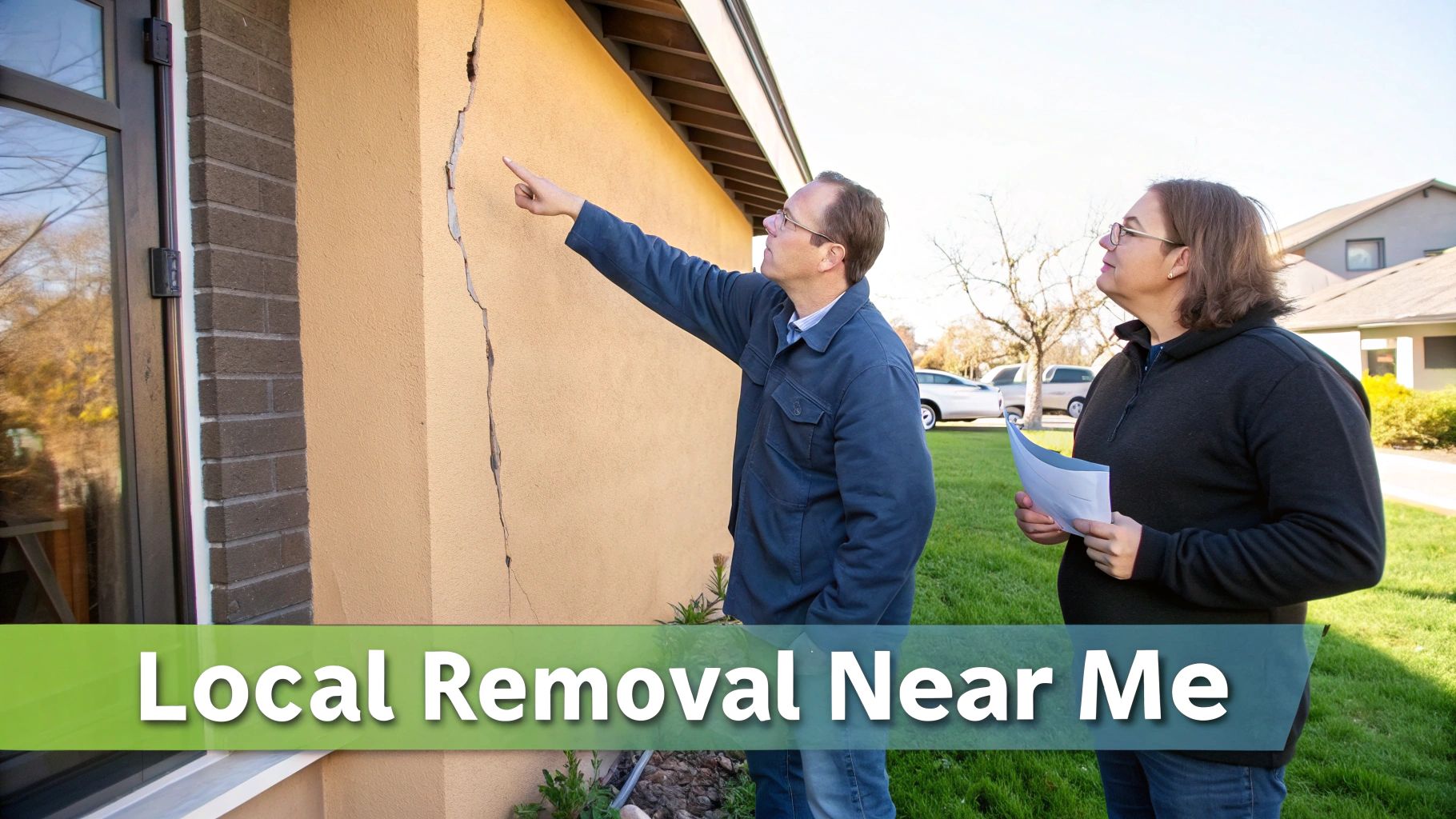
Your Essential Vetting Checklist
To hire a team you can actually trust, you’ve got to do your homework. Don’t feel awkward about asking for proof of their qualifications and credentials. A professional, reputable company will not only expect it, they’ll have all their documents ready to show you.
Here’s a practical checklist to get you started:
- HSE Licence Check: Ask for their licence number. Don’t just take their word for it – you can verify it. Any high-risk asbestos work requires this licence, and it’s your proof they’re trained to handle the nasty stuff.
- Specialist Insurance: Standard public liability insurance doesn’t cut it. They need specific cover for working with asbestos. Ask to see their current insurance certificate.
- Recent, Local References: Can they give you the details of a couple of similar jobs they’ve finished recently in your area? A quick chat with a past client is worth its weight in gold for getting a real feel for their work.
- Waste Carrier Licence: The firm must be licensed to transport hazardous waste. They should be able to give you their Environment Agency registration number without any fuss.
Working through these points will help you build a solid shortlist. Of course, knowing you have a problem is one thing, but getting the right help is the next crucial step. To make sure your project goes smoothly, it’s vital to understand how to find a good contractor you can truly rely on.
Key Questions to Ask Every Contractor
Once you’ve narrowed it down to a few companies, it’s time to dig a little deeper. How they answer these questions will tell you everything you need to know about their experience and their commitment to safety.
A contractor who knows their stuff should be able to answer these without missing a beat:
- “Can you show me a detailed plan of work before you start?” This isn’t just a rough outline; it should detail their exact methods for containment, removal, and air monitoring. A vague plan is a massive red flag.
- “How will you keep my family and home safe while you work?” They should be able to talk you through their containment procedures, like building sealed enclosures with negative air pressure and their use of proper personal protective equipment (PPE).
- “What kind of air testing happens after the job is done?” The only answer you want to hear is that an independent, UKAS-accredited analyst will carry out the clearance testing. The removal company should never do its own clearance tests.
- “How do you get rid of the asbestos waste?” They must use a licensed hazardous waste disposal site. Crucially, they must also give you a copy of the waste consignment note as proof. This is your legal paperwork showing the job was done by the book.
A true professional will welcome your questions. If a company gets defensive, dismisses your concerns, or tries to rush you into a decision, walk away. Your peace of mind is what matters most.
It’s also worth knowing that the rules are getting stricter. The UK’s asbestos regulations are being tightened as awareness of the ongoing risks grows. In fact, by the end of 2025, the UK government is pushing to have asbestos-containing materials removed from over 10,000 public buildings. This initiative will be supported by around 100,000 compliance inspections a year, which really drives home how important it is to hire a firm that follows the rules.
Spending a bit of extra time vetting your contractor is the best thing you can do for the safety of your home. For more advice on this vital decision, have a look at our in-depth guide on how to https://www.thewastegroup.co.uk/news/choose-the-right-asbestos-removal-company/.
Understanding the Removal Process and Costs
Discovering asbestos can be unsettling, but knowing what a professional removal job actually involves can take a lot of that anxiety away. This isn’t just about ripping out old materials; it’s a precise, highly controlled operation designed from the ground up to keep everyone safe. The entire project follows a strict, legally required sequence to ensure your property is left completely clear and safe to occupy.
It all starts with a proper asbestos survey and sample testing. This is the crucial first step that confirms exactly what you’re dealing with—the type of asbestos, where it is, and what condition it’s in. With that information, a licensed contractor will draft a detailed “plan of work,” which lays out every single step, from setting up the containment area to the final, thorough clean-up.
This plan isn’t just a friendly suggestion; it’s a legal document. It’s your assurance that the entire job will be done by the book, meeting the stringent safety standards set by the Health and Safety Executive (HSE).
The Critical Safety Protocols in Action
Once the plan is approved, the real work begins. Before a single bit of asbestos is touched, the team constructs an airtight containment area. This is one of the most vital stages for any licensed asbestos removal project, and it’s non-negotiable.
Think of it as a sealed bubble built around the work zone using heavy-duty polythene sheeting and timber frames. This enclosure is then fitted with a specialised ventilation system that creates negative air pressure. This is a clever bit of engineering that works like a vacuum, making sure that if any microscopic fibres are disturbed, they get trapped inside the containment and pulled through high-efficiency filters instead of escaping into your home.
Every person who enters this sealed-off area must be in full personal protective equipment (PPE). We’re talking disposable coveralls and advanced respiratory gear. It’s not optional—it’s fundamental for protecting the team and preventing any chance of cross-contamination.
To further clamp down on fibre release, contractors use a technique called wetting. They spray the asbestos-containing materials with a fine mist of water mixed with a special surfactant, keeping everything damp as it’s removed. It’s a simple but incredibly effective method that dramatically cuts down on dust and stops fibres from becoming airborne in the first place.
Deconstructing the Costs of Asbestos Removal
A quick search for “asbestos removal near me” will bring up plenty of companies, but what actually goes into the quote they give you? Several key factors influence the final price, and understanding them will help you spot why a surprisingly cheap quote should be a massive red flag.
The cost is never a simple per-square-metre figure. A professional quote is always built on a detailed assessment of the specific job at hand.
The image below gives you a clear overview of how a professional project flows, from the initial survey right through to getting the final all-clear.
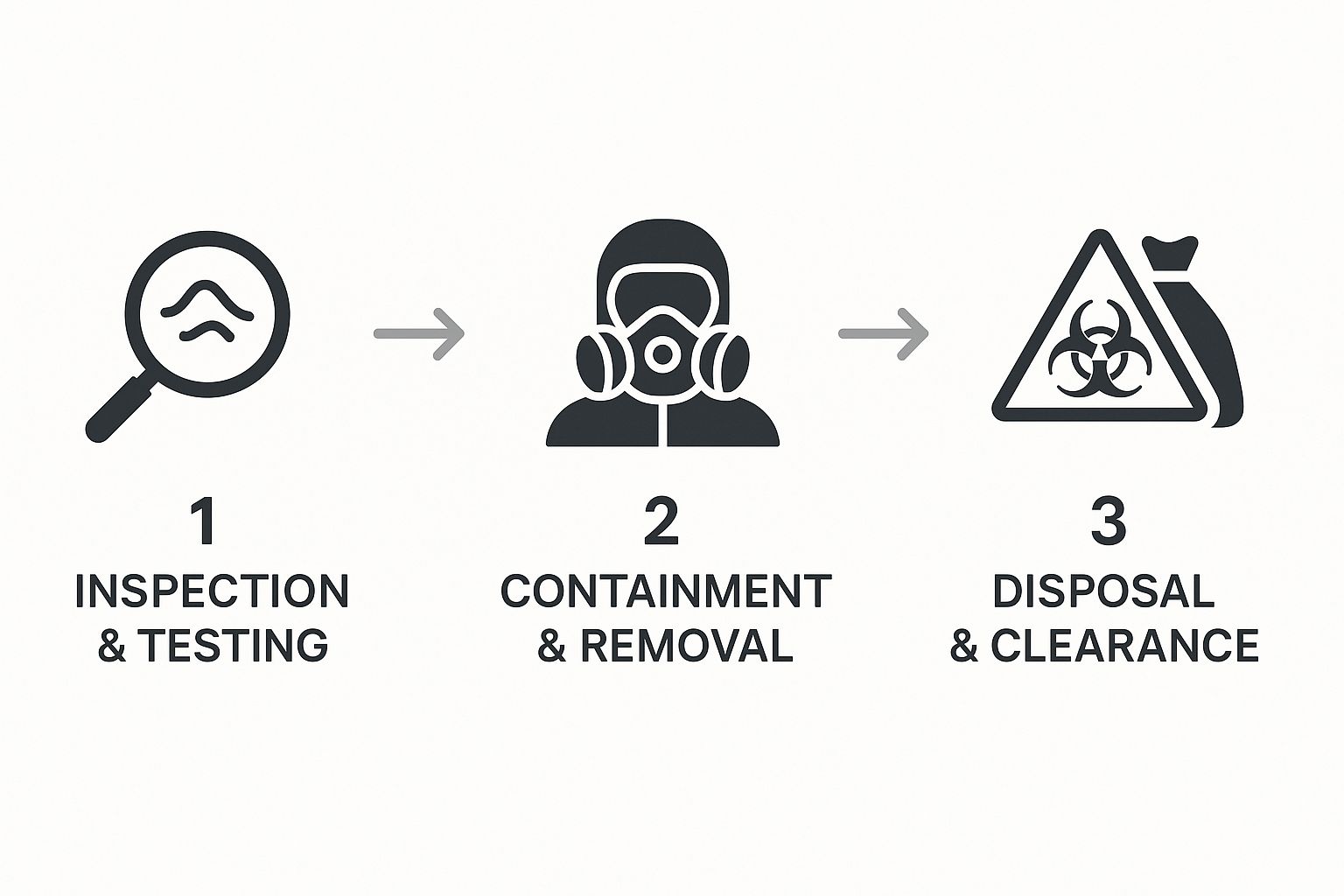
As you can see, a safe removal is a multi-stage process with safety checks and compliance measures baked in at every point.
Here are the main things that will determine your final bill:
- Type of Asbestos: Friable (easily crumbled) materials like insulation board (AIB) or old pipe lagging need far more complex—and therefore more expensive—containment than non-friable asbestos cement sheets on a garage roof.
- Amount and Condition: Removing a small, intact panel is much cheaper than dealing with a large, crumbling ceiling. The more damaged the material, the higher the risk, and the more rigorous the safety measures have to be.
- Accessibility: An asbestos water tank tucked away in a cramped loft is going to cost more to remove than an easily accessible garage roof. Difficult-to-reach areas require more time, labour, and sometimes specialised equipment.
All these variables are carefully weighed up when a quote is put together. This is precisely why a proper on-site survey is essential before any price can be confirmed.
To give you a realistic idea of what to budget for, we’ve put together some ballpark figures for common asbestos removal jobs in the UK. Just remember, these are only estimates. The final cost will always depend on the unique circumstances of your property.
Estimated UK Asbestos Removal Costs for Common Projects
The table below provides a guide to potential costs for typical asbestos removal projects. It’s designed to help homeowners and property managers get a better handle on budgeting for a safe and compliant job.
| Project Type | Estimated Cost Range (£) | Key Cost Factors |
|---|---|---|
| Asbestos Garage Roof Removal | £600 – £1,500 | Size of the roof, condition of the cement sheets, and ease of access. |
| Artex Ceiling Removal (per room) | £800 – £2,500+ | Room size, whether it’s a full removal or encapsulation, and ceiling height. |
| Vinyl Floor Tiles Removal (per room) | £500 – £1,200 | Area of the floor, type of adhesive used (some also contain asbestos), and condition of the tiles. |
| Asbestos Insulation Board (AIB) | £75 – £150 per square metre | Location (e.g., soffits, wall panels), condition, and the complexity of the containment needed. |
| Pipe Lagging Removal | Quoted on a per-job basis | Highly variable based on length, location (e.g., crawl spaces), and condition. |
These figures should give you a more confident starting point for your budget and a clearer understanding of the investment needed to get the job done right.
Final Checks After the Removal Is Complete
Just because the contractor’s van has driven away doesn’t mean the job is finished. This last stage is arguably the most important one for your peace of mind. It’s all about getting official, independent confirmation that your home is safe to live in again and securing the legal paperwork to prove it.
Skipping these final checks simply isn’t an option. They’re your ultimate guarantee that the hazardous materials have been dealt with properly, leaving no lingering risks behind. This is the part of the process that formally closes the loop.
The Non-Negotiable Air Clearance Test
Once the removal team has finished their work and done an initial clean-up, an independent analyst has to come in. This is a critical point: the company that removed the asbestos should never be the one signing off on their own work. An impartial, third-party check is the only way to get unbiased results you can trust.
Make sure this analyst is UKAS-accredited (United Kingdom Accreditation Service). This accreditation is the gold standard, confirming they have the right expertise and equipment to do the job properly.
The test itself involves aggressive air sampling. The analyst will deliberately disturb the air in the sealed-off area, often with a leaf blower, to mimic a worst-case scenario. These air samples are then analysed right there on-site to count any remaining airborne fibres.
A successful air clearance test must show fibre levels are below the control limit of 0.01 fibres per cubic centimetre (f/cm³) of air. Only when this incredibly low threshold is met can the area be considered safe for reoccupation.
Understanding Your Certificate of Reoccupation
After the air test gets the all-clear, the analyst issues a ‘certificate of reoccupation’. This isn’t just a piece of paper; it’s your official, legally recognised proof that the area is safe to enter without needing respiratory protection.
This certificate confirms three key things:
- A visual inspection found no leftover debris.
- The air clearance test was passed.
- The area has been formally declared clean and safe.
You’ll want to keep this certificate safe with your other property documents. It’s vital evidence that the asbestos removal was handled correctly, which can be important if you ever sell or renovate in the future. It’s the definitive sign-off on a job well done.
This verification is so critical because asbestos-related diseases still cause around 5,000 deaths in the UK each year. New data shows that mesothelioma, a cancer almost entirely caused by asbestos, was responsible for 2,218 deaths in 2023 alone. You can discover more insights about Britain’s ongoing asbestos epidemic and see why these final checks are so vital.
Verifying Correct Asbestos Disposal
The last piece of the puzzle is making sure the asbestos waste itself has been disposed of legally and safely. Your contractor can’t just take it to the local tip; they have a legal duty to transport this hazardous material to a specially licensed facility.
To prove they’ve done this, they must give you a copy of the waste consignment note. This is the legal document that tracks the asbestos from your property all the way to its final disposal point.
The consignment note should clearly show:
- Your address, where the waste was collected.
- A description of the asbestos waste.
- Details of the licensed disposal site where it was taken.
- Signatures from your contractor and the disposal site.
Getting a copy of this document is non-negotiable. Without it, you have no proof the hazardous waste from your home wasn’t fly-tipped somewhere, creating a danger for others and a potential legal headache for you. This paperwork is your final guarantee of a responsible, compliant removal process. Managing hazardous waste properly is a key part of environmental stewardship, a concept closely related to understanding the carbon footprint of your waste.
Common Questions About Asbestos Removal

Even when you’ve done your homework, it’s completely normal to have a few nagging questions about asbestos. Let’s face it, the process can feel a bit overwhelming, and getting solid, straightforward answers is the key to feeling confident you’re making the right call.
We’ve pulled together some of the most common queries we hear from UK homeowners. Think of this as a quick reference for those specific concerns that often pop up.
What Is the Difference Between a Management and a Refurbishment Survey?
This is probably the biggest point of confusion for most people, but getting it right is vital for safety and staying on the right side of the law. The two surveys are designed for very different situations.
- Asbestos Management Survey: This is your standard, less intrusive check. The main goal here is to find any asbestos-containing materials (ACMs) that could be disturbed during normal, everyday life in a building. It’s essentially a risk assessment to help you manage any asbestos that’s already there.
- Refurbishment/Demolition Survey: As the name suggests, this is a much more thorough, invasive survey. It’s a legal requirement before you start any major work like knocking down walls, extending your home, or a full demolition. The surveyor has to get into every nook and cranny – behind walls, under floors, and into structural voids – to find all hidden asbestos. This is to make sure construction work doesn’t accidentally release dangerous fibres.
Getting a Management Survey when you’re about to start a big renovation is a classic, and dangerous, mistake. Always be crystal clear with your surveyor about what your plans are for the property.
How Long Does Asbestos Removal Typically Take?
There’s no single answer here, as the timeline really depends on the job. But for most residential projects, it’s often quicker than you might think. A straightforward job, like taking down an asbestos cement garage roof, can often be done and dusted in a single day.
For more complex work, like tackling an Artex ceiling or dealing with old pipe lagging inside the house, you’re probably looking at 2-3 days. That timeframe includes setting up the sealed enclosure, performing the actual removal, and the all-important independent air testing at the end. Your chosen contractor should give you a clear schedule in their plan of work.
Don’t forget, the air clearance test at the end is non-negotiable and adds a few hours to the final day. If a company is promising an unbelievably quick turnaround, they might be cutting corners on these essential safety steps.
Can I Live in My House During the Removal Process?
This one really boils down to where the work is happening. If the asbestos is in a separate, contained area like an outbuilding, garage, or shed, you can usually stay put without any issues.
However, if the removal is taking place inside your main living space—like the kitchen, a bedroom, or the lounge—we strongly advise that you and your family find somewhere else to stay. While the sealed work area is designed to be completely airtight, moving out for a day or two removes any shred of potential risk. It also gives the contractors the space they need to work safely and get the job done right.
At The Waste Group, we know that dealing with hazardous materials like asbestos demands real expertise and a company you can trust. If you’re looking for a compliant, safe, and reliable asbestos disposal service in Dorset and the surrounding areas, our experienced team is here to help. We make sure every single step is handled according to strict regulations, giving you total peace of mind. Find out more about our professional solutions and get a quote at The Waste Group.
